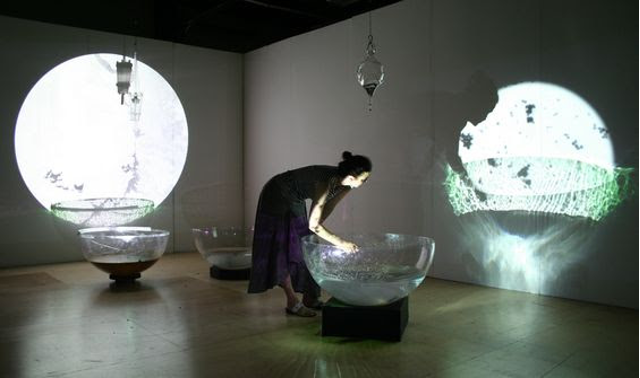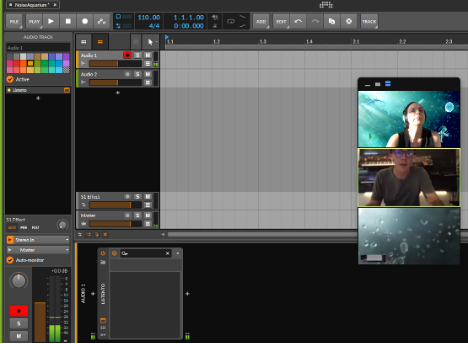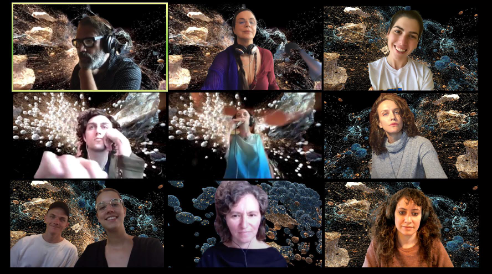
Victoria Vesna, Ph.D., is an artist and UCLA professor whose work combines research, science, art, and technology to create immersive and provocative experiences for audiences and students alike. After formal training as a painter at the Academy of Fine Arts, Belgrade (1984), her cross-disciplinary mindset and curious nature drove her to explore the gaps and intersections among communication technologies, virtual worlds, and art. Many of her projects are inspired by pollution and climate change and emphasize the global interconnectedness of humans with their environment.
Currently, she is a professor at UCLA’s Department of Design Media Arts, and she serves as Director of the Art|Sci center at the School of the Arts and California Nanosystems Institute (CNSI). She has featured over 30 solo exhibitions and has connected with several nanoscientists, biologists, and artists to create over 100 collaborative, boundary-defying projects.
We recently caught up with Victoria to discuss how she integrates art, science, and climate awareness.
How did you become interested in environmental issues and begin to integrate them into your art?
Looking back, I think my journey started when being confronted with pollution and chemicals in my immediate environment. After finishing art school, by ‘chance’, I got an opportunity to intern in Andy Warhol’s silkscreen factory in Tribeca, NY. This was significant not only in what I learned in technique and production but also by witnessing first-hand the underbelly of the art world. The conditions were unhealthy with hardly any ventilation and the staff wore gas masks the entire time we were printing. In short, I was disillusioned and considered it a gift to be freed from being starry eyed or longing for being accepted by the art world. Plus, I enjoyed night clubs more than galleries and was in a post punk band for a few active years. At the end of a year-long internship, I used the same gas mask to produce a video performance in reaction to the Bhopal accident in India. Learning about this horrendous accident was really upsetting but even more was the lack of response with little or no public recognition. The city was decorated for Christmas, shopping was in full motion, and no one seemed to care as it was far away. I felt compelled to do something and walked the city as the ghost of this event. Thus, emerged On the Street with Bast: Bhopal Christmas street performance that was eventually shown in many video art festivals. Interest and research into how anthropocentric pollution is generated very quickly connects to causes of climate change. VIDEO
MORE about the Bhopal accident — “On December 3, 1984, 40 tons of a toxic gas spewed from the factory and scorched the throats, eyes, and lives of thousands of people outside these walls. It was — and still is — the world’s deadliest industrial disaster.”
This idea of tragedies happening “over there” on the other side of the world still bothers me. We are all citizens of one planet, and all is connected. In other words, if one part of your body is suffering from pollution and sickness, the rest will be affected, and if you don’t pay attention, the cancer can spread. You can see this now with the pandemic – as one part of the world gets healthier, another is having an outbreak, but often these events are treated as unrelated. It is critical to raise awareness of the interconnected nature of all sentient beings.
Your project “Water Bowls” is rooted in the concept of each person being “emotionally connected” to a specific body of water. What inspired this idea, and how did you use technology and science to create this interactive experience?
Previous to Water Bowls, I was working on NANO — a series of interactive works that were installed at LACMA in collaboration with nanoscientist James Gimzewski and a team of artists, scientists, technologists and sound artists. The world of cells and frequencies led to a fascination with the strange behavior of water molecules and the idea of the Fourth State of Water. I started to extensively research water as a life-giving element, which led me to underwater noise as well as to oil and plastic pollution and, in general, to looking at the impending disaster of water shortage and pollution.
Water Bowls: moon, drop, sound, oil consists of four large containers — half full or half empty. The installation is set up as a meditative space that, at first, seems very beautiful; but the longer you stay, the more you discover the disturbing state of water. The audience is invited to touch the water and make noise, create a disturbance and influence the state of the environment through projection and sound—we are all implicated.

Image courtesy of Victoria Vesna
Some of the most common metaphorical associations of water — such as the reflection of the moon, a drop of water, the sound of water, as well as oil and water — are revisited through using some of the latest scientific observations. The bowls “Moon” and “Sound” were envisioned to be locally interactive, while “Drop” and “Oil” were interactive both locally and remotely, emphasizing the global connectivity of both water and human systems, beyond borders.
But I wanted to continue the work and highlight all those who are actively engaging in research related to water. In collaboration with Claudia Jacques, Water Bodies was conceptualized — it is a site where those who work with water are invited to submit work. All of us have a water body that we are emotionally connected to — a stream, river, lake, sea, ocean, and it may not be in our immediate environments. The idea is to feature and invite artists or scientists to become a Water Keeper and connect to others who share that bond with a particular water body.
Working with hydrophones and sound / projection waves, I started learning more about underwater noise pollution, and this eventually led to working on a piece with planktons.

Image courtesy of Victoria Vesna
NOISE AQUARIUM, one of your more recent projects, reveals how noise pollution affects marine microorganisms, and “ALIEN STAR DUST: Signal to Noise” highlights the paths of stardust being disrupted by climate change, deforestation, and human-made dust. What are some ways that science and research influenced specific aspects of these projects?
The artwork NOISE AQUARIUM used existing visualizations as an anchor to create an experience that amplifies the importance of plankton for life on Earth by submerging the participants in sounds of underwater noise pollution and prompting them to center and balance themselves. Many of us are still not aware that plankton is a central source of the oxygen we breathe and that the noise pollution underwater is destroying so much of the marine life that has a direct impact on all living beings. The aim is to show that, even though we do not see the plankton with our naked eye or hear the noise deep down in the oceans and seas, we are all implicated due to the destructive effects of our excessive exploitation of resources, which has thrown our planet out of balance.
Looking at making the invisible – visible, and the inaudible – audible, has been the focus of my work for a long time and this interest takes me into deeper understanding of the complexity of the ecology we are part of. And, in particular, I became very interested in frequencies, vibrations – both positive and negative. Noise pollution in relation to our mental well-being and the underwater noise pollution that we are not in direct contact with but has great consequences for our lives. We all know that noise pollution can affect large mammals that communicate with sonar and vibration, and we have seen images about dolphins and whales being affected by this noise. My question is — what happens with the micro creatures — the planktons?
And, as I was exploring that, I also found out something that was very disturbing — that the planktons are actually starting to eat micro and nano plastics! If you stop and think about what that means — the bottom of the food chain is eating micro-plastics, which means they either die or they continue taking the micro-plastics up the food chain ladder. And at the invitation of Dr. Alfred Vendl, director of scientific visualization at the University of Applied Arts in Vienna, I started working with animator Martina Froeschl. I came up with an idea of how to make this really immersive and make people think and feel what it’s like to be underwater in this noise, and how amazing and diverse these creatures are. All of these creatures were blown up to be as big as whales.
Almost 70% of the air we breathe out on this planet is produced by plankton. Most think it is trees and forests, but it’s really plankton that is creating the oxygen we breathe and if planktons are damaged, everything gets affected. Noise Aquarium is meant to bring this message to the audience through experience — both as linear video projection and in Virtual Reality where you stand on an interactive stand, and then affect how the planktons move. If you are able to stand still and center yourself, you see the plankton. But most of the time, people destroy the plankton and create loud noise that is sonar, shipwreck and underwater explosion recordings.
VIDEO – Ars Electronica Deep Space
ALIEN STAR DUST: Signal to Noise draws from the collection of meteorites at the Natural History Museum in Vienna. I was commissioned to do an installation in the meteorite gallery and, after some research, got fascinated with star dust. Star dust is 1/10th of a width of a human hair and 100 tons falls on earth every single day, and they hold the mystery of our cosmic roots. Micrometeorite hunters are presented with the challenge of finding a space spherule in the midst of human made dust, which is mostly pollution. It is truly as if one were looking for a needle in a haystack.
But this became interesting to the artist — collecting samples of dust in various locations and comparing the composition of dust that we breathe in daily, including possibly space dust occasionally. Earthly wind and weather move around the planet these dust particles, and it is more and more complicated to understand and predict the movement or consequence with climate disruptions.
Both of these works have migrated online during the pandemic in form of an online collective meditations with edited visuals and re-composed binaural sound.
ONLINE MEDITATION – Winter Solstice, Integratron, CA


Images courtesy of Victoria Vesna
Have you ever found it challenging to bring together art, technology, and environmental awareness? If so, how did you go about these challenges?
The challenge is to have patience and time for the different ways of viewing the world to come together. Artists, technologists, scientists and environmentalists all have different education and methodologies and sometime even the same word has different meanings. The only way that I found to be effective is when real friendships evolve and we talk as humans — over dinner or a coffee. If we like spending time with each other on this level, we will make the effort to explain and make room for the collaboration to emerge. There must be a willingness to have a porous space that would change our established patterns of thinking and behavior and merge into something third. This is the space where magic can happen — in between.
Why do you think the use of art and science together can inspire audiences to act on climate change and other environmental issues more effectively than art or science alone? In the midst of worsening climate change, what do you hope people take away from your projects?
The immersive installation and online meditations are meant to pull the audiences into the non-verbal experiential realm. The hope is that this experience would bring people into a shift of perception – away from the individualistic, separated point of view to a collective, ecological sense of all being interconnected. Science alone can be difficult to understand and often is related in a didactic way that turns people off. Art can be focused on aesthetic or can be grounded in personal interpretation not based on facts, so it may not have as a powerful effect as when combined with science as a base. This is not to say that the work should be educational and / or didactic — it takes a lot of back and forth to get it to the point where the research holds together the poetics of the work.
In conjunction with being an innovative artist, you are also an interdisciplinary professor. What role does the intersection of climate science, art, and technology play in education, and why do you think integrating a cross-disciplinary curriculum is important in education?
Education is still based on the old industrial model — separating disciplines with reductionist scientific education is the source of all our problems. The system is so crystalized that we can only go around it, and it also happens quite naturally outside of it. Students really want this kind of interaction, and it is sad to see how slow it is changing and sometimes frustrates me as a professor. I am passionate in my belief that breaking down the disciplinary boundaries is the only way we can deal with the urgency of climate change. This is not to say that there is no need for specialized areas — it is more about the way the communication and collaboration is taught. In other words, if you work on only researching one molecule, but at the same time have an awareness of how moving that one piece of the puzzle affects the rest, the work is bound to be much more productive.
Some Classes:
Fiat Lux class: HOX ZODIAC: Eat or Be Eaten
Honors class: NanoBiotech & Art
Graduate seminar: Vibrations Matter
What advice would you give to someone who wants to get involved in climate action, art, and science?
Start by being mindful of your own actions in daily life, connect to people who share your values, and use your strengths, whatever they are, to help raise awareness. There is a large community out there already working and the network is getting larger by the day. Look around and join those you resonate with.
Where or how can folks learn more about and view your projects and artwork?
Victoria Vesna homepage
UCLA Art Sci center – sign up to our newsletter